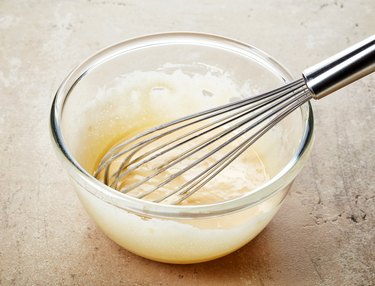
Buttermilk derives its name from being the leftovers of making butter. Since almost all of the liquid's fat goes to the butter, the milk that's left is actually quite lean. Its rich thickness is a result of the slight "souring" from the formation of lactic acid due to bacteria in the milk. The acidity of buttermilk plays a vital role in many recipes, especially quickbreads like biscuits and pancakes, as it balances the alkalinity of baking soda. The chemical reaction between acid and alkaline causes quickbreads to rise. If you don't have any buttermilk on hand, however, you can easily make a substitute from cream and vinegar.
Step 1
Measure out the amount of buttermilk called for in your recipe into a small bowl or glass measuring container.
Video of the Day
Step 2
Add 1 tbsp. vinegar or lemon juice for every cup of milk or cream needed. For example, if your recipe calls for 1 ½ cups buttermilk, combine 1 ½ cups milk or cream and 1 ½ tbsp. vinegar or lemon juice.
Step 3
Stir the mixture thoroughly.
Step 4
Allow the mixture to sit for about five minutes before adding it to your recipe. The milk will begin to look curdled, which is normal.
Things You'll Need
1 cup cream
Bowl or measuring cup
1 tbsp. apple cider vinegar, distilled vinegar or lemon juice
Tip
This method also works for making a vegan buttermilk version; just use your favorite non-dairy milk.
Warning
Using cream as the base for your buttermilk substitute will increase the fat and calorie content of your recipe. For a healthier option, use non-fat cream or low-fat milk.
Video of the Day